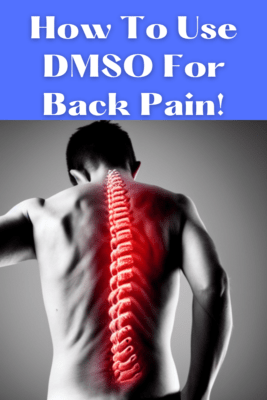Benefits Of DMSO For Back Pain Relief
When it comes to dealing with back pain, many people are on the lookout for effective and natural remedies. One such remedy that has been gaining attention is DMSO, or dimethyl sulfoxide. If you’ve never heard of it before, you’re not alone. DMSO is a byproduct of wood pulp and has been used for various medical purposes since the 1960s. But what makes it particularly interesting is its potential benefits for back pain relief. BEST DMSO WITH CBD FOR BACK PAIN!!
First and foremost, DMSO is known for its anti-inflammatory properties. Inflammation is a common culprit behind back pain, whether it’s due to an injury, arthritis, or another underlying condition. By reducing inflammation, DMSO can help alleviate the pain and discomfort that often accompany back issues. This is particularly beneficial for those who suffer from chronic back pain and are looking for a more natural alternative to over-the-counter anti-inflammatory medications.
Moreover, DMSO has analgesic properties, meaning it can help reduce the sensation of pain. This is especially useful for those who experience acute back pain episodes. When applied topically, DMSO penetrates the skin and reaches the affected area quickly, providing almost immediate relief. This rapid action can be a game-changer for individuals who need quick pain relief to go about their daily activities.
Another noteworthy benefit of DMSO is its ability to enhance the absorption of other medications. This means that if you’re using other topical treatments for back pain, DMSO can help these treatments work more effectively. It acts as a carrier, allowing other medications to penetrate deeper into the tissues, thereby increasing their efficacy. This can be particularly useful for those who are using a combination of treatments to manage their back pain.
In addition to its anti-inflammatory and analgesic properties, DMSO also has muscle-relaxant effects. Muscle tension and spasms are common issues that contribute to back pain. By relaxing the muscles, DMSO can help reduce the strain on your back, making it easier to move and function without discomfort. This can be especially beneficial for those who experience muscle-related back pain due to physical activity or stress.
Furthermore, DMSO is relatively easy to use. It is available in various forms, including gels, creams, and liquids, making it convenient to apply. However, it’s important to note that DMSO should be used with caution. Always make sure to use it as directed and consult with a healthcare professional before starting any new treatment, especially if you have underlying health conditions or are taking other medications.
While DMSO offers several potential benefits for back pain relief, it’s essential to remember that it may not work for everyone. Individual responses to treatments can vary, and what works for one person may not necessarily work for another. Therefore, it’s crucial to approach DMSO with an open mind and be willing to explore other options if needed.
In conclusion, DMSO presents a promising natural remedy for back pain relief, thanks to its anti-inflammatory, analgesic, and muscle-relaxant properties. Its ability to enhance the absorption of other medications further adds to its appeal. However, as with any treatment, it’s important to use DMSO responsibly and consult with a healthcare professional to ensure it’s the right choice for you. If you’re struggling with back pain and looking for a natural alternative, DMSO might just be worth considering.
How DMSO Works To Alleviate Back Pain
Dimethyl sulfoxide, commonly known as DMSO, has been a topic of interest for those seeking alternative treatments for back pain. If you’ve been struggling with back pain and are curious about how DMSO might help, you’re not alone. Many people are turning to this compound, hoping for relief. But how exactly does DMSO work to alleviate back pain? Let’s dive into the details.
First off, it’s important to understand that DMSO is a byproduct of wood pulp and has been used for various medical purposes since the mid-20th century. Its unique properties make it a versatile compound, particularly in the realm of pain management. One of the primary ways DMSO helps with back pain is through its anti-inflammatory effects. Inflammation is a common culprit behind many types of back pain, whether it’s due to muscle strain, arthritis, or other conditions. When applied topically, DMSO penetrates the skin and reduces inflammation at the source, providing relief.
Moreover, DMSO is known for its ability to enhance the absorption of other medications. This means that if you’re using other topical treatments for back pain, DMSO can help these medications penetrate deeper into the tissues, making them more effective. This synergistic effect can be particularly beneficial for those who have tried other treatments with limited success.
Another fascinating aspect of DMSO is its analgesic properties. It works by blocking certain nerve pathways that transmit pain signals to the brain. This can provide almost immediate relief for acute back pain, making it a popular choice for those who need quick, effective pain management. Additionally, DMSO has been shown to improve blood flow to the affected area, which can speed up the healing process. Improved circulation means that more oxygen and nutrients are delivered to the tissues, aiding in recovery.
It’s also worth mentioning that DMSO has antioxidant properties. Oxidative stress can exacerbate pain and inflammation, so by neutralizing free radicals, DMSO helps to create a more favorable environment for healing. This multi-faceted approach makes DMSO a compelling option for those dealing with chronic back pain.
However, like any treatment, DMSO is not without its drawbacks. Some people may experience skin irritation or a garlic-like odor when using it. It’s always a good idea to do a patch test first to see how your skin reacts. Additionally, while DMSO is available over-the-counter in some places, it’s crucial to consult with a healthcare provider before starting any new treatment regimen. They can provide guidance on the appropriate concentration and application method, ensuring that you get the most benefit with the least risk.
In summary, DMSO offers a promising alternative for back pain relief through its anti-inflammatory, analgesic, and antioxidant properties. Its ability to enhance the absorption of other medications and improve blood flow further adds to its appeal. While it may not be a one-size-fits-all solution, many people have found significant relief from their back pain by incorporating DMSO into their treatment plan. If you’re considering giving it a try, be sure to consult with a healthcare professional to determine if it’s the right option for you.
Comparing DMSO To Traditional Back Pain Treatments
When it comes to managing back pain, the options can seem endless and often overwhelming. From over-the-counter medications to physical therapy, and even surgical interventions, the choices are vast. One treatment that has been gaining attention is DMSO, or dimethyl sulfoxide. But how does it stack up against more traditional back pain treatments? Let’s dive into the comparison.
First, let’s talk about what DMSO actually is. Originally used as an industrial solvent, DMSO has found its way into the medical world due to its anti-inflammatory and analgesic properties. It’s often applied topically and is believed to penetrate the skin quickly, delivering relief directly to the affected area. This is quite different from traditional oral medications like ibuprofen or acetaminophen, which need to be ingested and then metabolized by the body before they can start working.
Speaking of oral medications, they are usually the first line of defense against back pain. They are convenient and can be effective for mild to moderate pain. However, they come with their own set of drawbacks. Long-term use of NSAIDs (non-steroidal anti-inflammatory drugs) can lead to gastrointestinal issues, while acetaminophen can be taxing on the liver. In contrast, DMSO is applied directly to the skin, potentially reducing the risk of systemic side effects. This makes it an appealing option for those who are wary of the long-term consequences of oral medications.
Physical therapy is another cornerstone of traditional back pain treatment. It focuses on strengthening the muscles around the spine, improving flexibility, and teaching proper body mechanics. While highly effective, physical therapy requires a significant time commitment and consistency. DMSO, on the other hand, can be applied quickly and easily at home, making it a more convenient option for those with busy schedules. However, it’s worth noting that DMSO doesn’t address the root causes of back pain, such as muscle imbalances or poor posture, which physical therapy aims to correct.
Then there’s the option of surgical intervention, which is usually considered a last resort. Surgery can be highly effective for certain conditions like herniated discs or spinal stenosis, but it comes with inherent risks and a lengthy recovery period. DMSO offers a non-invasive alternative that can provide relief without the need for anesthesia, incisions, or a hospital stay. However, it’s important to remember that DMSO is not a cure-all and may not be effective for severe or structural issues that require surgical correction.
Another traditional treatment worth mentioning is the use of topical creams and patches, which often contain ingredients like menthol, capsaicin, or lidocaine. These products can provide localized relief and are generally easy to use. DMSO falls into this category but stands out due to its unique ability to penetrate deeper into the tissues. This deeper penetration could potentially offer more effective relief, especially for chronic or deep-seated pain.
In summary, while DMSO presents a promising alternative to traditional back pain treatments, it is not without its limitations. It offers the convenience of topical application and a reduced risk of systemic side effects compared to oral medications. However, it doesn’t address the underlying causes of back pain like physical therapy does, nor can it replace the need for surgical intervention in severe cases. As with any treatment, it’s essential to consult with a healthcare provider to determine the best course of action for your specific condition.
DMSO Application Methods For Back Pain
When it comes to managing back pain, many people are on the lookout for effective and natural remedies. One such option that has been gaining attention is DMSO, or dimethyl sulfoxide. This organic compound, derived from wood pulp, has been used for decades in various medical applications. But how exactly can you use DMSO for back pain relief? Let’s explore some of the most common application methods and see how they might fit into your pain management routine.
First off, it’s important to understand that DMSO is typically available in two forms: a liquid solution and a gel. Both forms can be applied topically, meaning you can put them directly on your skin where you’re experiencing pain. The liquid form is often preferred for its ease of application and quick absorption. To use it, you simply pour a small amount onto a clean cloth or cotton ball and then rub it onto the affected area. The gel form, on the other hand, is thicker and can be easier to control, especially if you’re dealing with a localized area of pain. You just squeeze a small amount onto your fingers and massage it into your skin.
One of the key benefits of DMSO is its ability to penetrate the skin and underlying tissues quickly. This means that it can deliver its pain-relieving properties directly to the source of your discomfort. Many users report feeling relief within minutes of application, which can be a game-changer if you’re dealing with chronic or severe back pain. However, it’s worth noting that DMSO has a distinct odor, often described as similar to garlic or oysters, which some people find off-putting. If you’re sensitive to smells, this is something to keep in mind.
Another popular method of using DMSO for back pain is to combine it with other therapeutic agents. For instance, some people mix DMSO with essential oils like peppermint or eucalyptus, which are known for their analgesic and anti-inflammatory properties. This combination can enhance the overall effectiveness of the treatment, providing a more comprehensive approach to pain relief. To do this, you would mix a few drops of your chosen essential oil with the DMSO before applying it to your skin. Just be sure to do a patch test first to ensure you don’t have any adverse reactions.
In addition to topical application, some people also use DMSO in conjunction with other treatments like physical therapy or chiropractic care. The idea here is that DMSO can help to reduce inflammation and improve circulation, making it easier for your body to heal and respond to other forms of treatment. For example, you might apply DMSO before a physical therapy session to help loosen up tight muscles and reduce pain, allowing you to get more out of your exercises.
While DMSO can be a valuable tool in your back pain management arsenal, it’s crucial to use it responsibly. Always start with a small amount to see how your body reacts, and consult with a healthcare professional if you have any concerns or pre-existing conditions. Additionally, make sure to use high-quality, medical-grade DMSO to ensure safety and efficacy.
In summary, DMSO offers several application methods that can be tailored to your specific needs and preferences. Whether you opt for the liquid or gel form, use it alone or in combination with other therapeutic agents, or incorporate it into a broader treatment plan, DMSO has the potential to provide significant relief from back pain. As always, listen to your body and consult with a healthcare provider to find the best approach for you.
Potential Side Effects Of Using DMSO For Back Pain
When it comes to managing back pain, many people are willing to try just about anything to find relief. One option that has garnered attention is DMSO, or dimethyl sulfoxide. While some swear by its effectiveness, it’s crucial to be aware of the potential side effects before deciding if it’s the right choice for you.
First and foremost, it’s important to understand that DMSO is a powerful solvent that can penetrate the skin and carry other substances with it. This unique property makes it an attractive option for delivering medications directly to the affected area. However, this same characteristic can also lead to unintended consequences. For instance, if DMSO is applied to the skin along with other chemicals or contaminants, it can carry those substances into the body, potentially causing harm.
One of the most commonly reported side effects of using DMSO is a garlic-like odor on the breath and skin. This occurs because DMSO is metabolized into dimethyl sulfide, which has a strong, distinctive smell. While this side effect is generally harmless, it can be off-putting and socially awkward for some people. Additionally, some individuals may experience skin irritation, such as redness, itching, or a burning sensation, particularly if they have sensitive skin or are using a high concentration of DMSO.
Another potential side effect to consider is the risk of allergic reactions. Although rare, some people may develop an allergic response to DMSO, which can manifest as hives, difficulty breathing, or swelling of the face, lips, tongue, or throat. If you experience any of these symptoms, it’s essential to seek medical attention immediately.
Moreover, DMSO can interact with certain medications, potentially altering their effects. For example, it may enhance the absorption of blood thinners, leading to an increased risk of bleeding. If you’re taking any prescription medications, it’s crucial to consult with your healthcare provider before using DMSO to ensure there are no harmful interactions.
In addition to these side effects, there is also the potential for long-term consequences that are not yet fully understood. While DMSO has been studied for various medical applications, its long-term safety profile remains unclear. Some animal studies have suggested that prolonged exposure to high doses of DMSO may cause damage to the liver and kidneys, but more research is needed to determine if these findings are applicable to humans.
Given these potential side effects, it’s essential to weigh the pros and cons of using DMSO for back pain. While some people may find relief with minimal side effects, others may experience more significant issues. It’s always a good idea to start with a lower concentration and gradually increase it if needed, while closely monitoring your body’s response.
In conclusion, while DMSO may offer some benefits for back pain relief, it’s not without its risks. Being aware of the potential side effects and taking precautions can help you make an informed decision about whether this treatment is right for you. Always consult with your healthcare provider before starting any new treatment, especially if you have underlying health conditions or are taking other medications. By doing so, you can ensure that you’re making the best choice for your health and well-being.
Scientific Studies On DMSO And Back Pain
When it comes to managing back pain, many people are willing to try just about anything to find relief. One treatment that has been gaining attention is DMSO, or dimethyl sulfoxide. But is DMSO really effective for back pain? To answer this question, we need to delve into the scientific studies that have explored its potential benefits.
First, let’s talk about what DMSO actually is. DMSO is a byproduct of wood pulp processing and has been used for various medical purposes since the 1960s. It’s known for its ability to penetrate the skin and other biological membranes, which makes it an intriguing candidate for delivering pain relief directly to the affected area. But how does it stack up when it comes to back pain specifically?
Several studies have investigated the efficacy of DMSO for pain relief, though not all of them focus exclusively on back pain. For instance, a study published in the journal “Pain” examined the effects of DMSO on patients with complex regional pain syndrome (CRPS), a condition that can cause severe, chronic pain. The researchers found that DMSO significantly reduced pain levels in these patients, suggesting that it has potent analgesic properties.
Transitioning to studies more directly related to back pain, there is some promising evidence. A small-scale study published in “Clinical Rheumatology” looked at patients with osteoarthritis of the spine, a common cause of chronic back pain. The participants applied a DMSO gel to the affected area and reported a noticeable reduction in pain and improved mobility. While this study was limited in scope, it does provide some support for the idea that DMSO can be beneficial for back pain sufferers.
Moreover, another study published in the “Journal of Pain Research” explored the use of DMSO in combination with other treatments. The researchers found that when DMSO was used alongside physical therapy and other conventional treatments, patients experienced greater pain relief compared to those who did not use DMSO. This suggests that DMSO might be particularly effective as part of a multi-faceted approach to pain management.
However, it’s important to note that not all studies have found DMSO to be effective. Some research has shown mixed results, with certain studies indicating minimal or no benefit. For example, a study in the “American Journal of Therapeutics” found that while DMSO did provide some pain relief, it was not significantly more effective than a placebo. This highlights the need for more extensive research to fully understand the potential benefits and limitations of DMSO for back pain.
In addition to the mixed scientific evidence, there are also some potential side effects to consider. DMSO can cause skin irritation, a garlic-like taste in the mouth, and other minor side effects. While these are generally not severe, they can be bothersome for some users.
So, is DMSO good for back pain? The answer isn’t entirely clear-cut. While there is some scientific evidence to suggest that it can be effective, particularly when used in combination with other treatments, more research is needed to confirm these findings and to better understand the optimal ways to use DMSO for back pain relief. If you’re considering trying DMSO, it’s always a good idea to consult with a healthcare professional to ensure it’s a safe and appropriate option for you.
Personal Stories: DMSO For Back Pain Relief
When it comes to dealing with back pain, many people are willing to try just about anything to find relief. One of the lesser-known remedies that has been gaining attention is DMSO, or dimethyl sulfoxide. While it might sound like something out of a chemistry lab, DMSO has been used for decades in various medical applications. But does it really work for back pain? To answer that question, let’s dive into some personal stories from individuals who have tried DMSO for their back pain relief.
Take Sarah, for instance. Sarah is a 45-year-old office worker who has been struggling with chronic lower back pain for years. She tried everything from physical therapy to over-the-counter painkillers, but nothing seemed to provide lasting relief. One day, a friend recommended she try DMSO. Skeptical but desperate, Sarah decided to give it a shot. She applied a small amount of DMSO gel to her lower back and waited. To her surprise, within 30 minutes, she felt a noticeable reduction in pain. Encouraged by the initial results, Sarah continued to use DMSO daily. Over time, she found that her back pain became more manageable, allowing her to return to activities she had long given up.
Similarly, John, a 60-year-old retired construction worker, had his own battle with back pain. Years of heavy lifting had taken a toll on his spine, leaving him with constant discomfort. John had heard about DMSO from a fellow retiree at his local community center. Intrigued, he decided to try it out. John started with a low concentration of DMSO, applying it to his back after his morning shower. He noticed a warming sensation followed by a gradual easing of his pain. For John, DMSO became a part of his daily routine, and he found that it significantly improved his quality of life.
Of course, not everyone has the same experience with DMSO. Take Emily, a 35-year-old yoga instructor who also suffered from occasional back pain. She decided to try DMSO after reading about its potential benefits online. However, after a few applications, Emily noticed that her skin became irritated and she developed a mild rash. Concerned, she discontinued use and consulted her doctor, who advised her that DMSO might not be suitable for everyone, especially those with sensitive skin.
These personal stories highlight the varied experiences people have with DMSO for back pain relief. While some find it to be a game-changer, others may not see the same benefits or might even experience side effects. It’s important to remember that what works for one person might not work for another. If you’re considering trying DMSO for your back pain, it’s a good idea to start with a small amount and monitor how your body reacts. Consulting with a healthcare professional before starting any new treatment is always a wise move.
In conclusion, DMSO has shown promise for some individuals in alleviating back pain, but it’s not a one-size-fits-all solution. Personal stories like those of Sarah, John, and Emily provide valuable insights into the potential benefits and drawbacks of using DMSO. Whether you’re at your wit’s end with chronic pain or just curious about alternative treatments, DMSO might be worth exploring, keeping in mind that individual results can vary.








